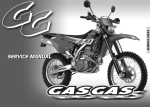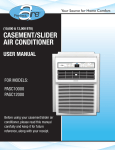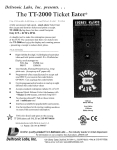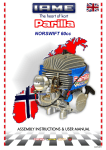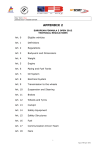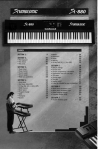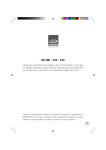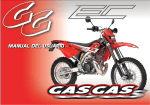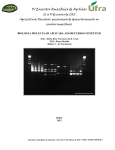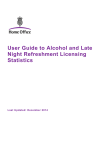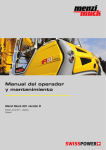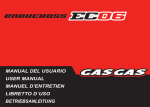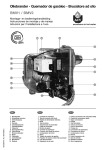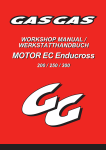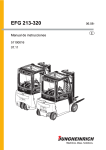Download SERVICE MANUAL SERVICE MANUAL
Transcript
SERVICE SERVICE MANUAL MANUAL Foreword GAS GAS thank you for your confidence By choosing the new GAS GAS EC 125/ 200/ 250/ 300 you have just entered the great GAS GAS family and, as a user of the number one off-road motorbike manufacturer, you deserve the distinguished treatment that we wish to offer to you both in our after-sale relationship and in the explanations that we provide in this manual. Our EC 125/ 200/ 250/ 300 is a bike conceived for the practice of high-competition enduro. It is actually the fruit of many years of competition and experimentation in this demanding discipline, as well as the many great successes achieved thanks to great trial riders who have contributed with their expertise to the basic data that have allowed us to create a high-level motorbike. Congratulations for making the right choice. With your skills at the commands of this motorbike, an adequate preparation and the indispensable servicing for this GAS GAS to be highly reliable, you will be able to enjoy the most comfortable and rewarding enduro practice. Thanks for your confidence and welcome to GAS GAS Motos. February 2003 EC 2003 -64- COMMON NOTICE Whenever you see the symbols shown below, heed their instructions! Always follow safe operating and maintenance practices. TO PROTECT THE FUTURE OF YOUR SPORT, MAKE SURE YOU USE YOUR BIKE LEGALLY, SHOW CONCERN FOR THE ENVIRONMENT, AND RESPECT THE RIGHTS OF OTHER PEOPLE. WARNING This warning symbol identifies special instructions or procedures which, if not correctly followed, could result in personal injury, or loss of live. Off-road motorcycle riding is a wonderful sport, and we hope you will enjoy it to the fullest. CAUTION This caution symbol identifies special instructions or procedures which, if noto strictly observed, could result in damage to or destruction of equipment. NOTE This note symbol indicates points of particular interest for more efficient and convenient operation. However, if improverly conducted, the sport has the potential to cause environmental problems as well as conflicts with other people. Responsible use of your off-road motorcycle will ensure that these problems and conflicts do not occur. EC 2003 -65- TABLE OF CONTENTS Foreword .........................................................................................64 Common notice ...............................................................................65 Table of contents .............................................................................66 Specifications ..................................................................................67 Location of Components .................................................................69 Side Stand.......................................................................................71 Fuel .................................................................................................71 Serial number..................................................................................73 Starting the engine ..........................................................................73 Shifting gears ..................................................................................74 Stopping the motorcycle .................................................................75 Table of maintenance ......................................................................76 Ignition timing ..................................................................................78 Cooling system................................................................................78 Spark plug .......................................................................................81 Transmission ...................................................................................81 Air cleaner .......................................................................................83 Throtlle cable...................................................................................84 Carburetor .......................................................................................84 Clutch ..............................................................................................85 Silencer packing change .................................................................85 Drive chain ......................................................................................86 Handlebar........................................................................................88 Brakes .............................................................................................89 Steering...........................................................................................90 Steering blocade .............................................................................91 Front fork.........................................................................................92 Rear suspension .............................................................................95 Wheel ..............................................................................................97 Cleaning ..........................................................................................98 Bolt and nut tightening ....................................................................99 Lubrication.....................................................................................101 Tunning (Carburetor and suspension) ..........................................102 Preparation check..........................................................................111 Storage..........................................................................................112 Gas Gas speedo instructions ........................................................112 Troubleshooting.............................................................................114 Warranty regulations .....................................................................118 EC 2003 -66- SPECIFICATIONS ENGINE Engine 125 cc. Bore and stroke Displacement in cubic centimeters 2 cycle, single cylinder, crank case induction, liquid cooled 54 x 54.5 mm. 124 cc. Engine 200 cc. Bore and stroke Displacement in cubic centimeters 62.5 x 65 mm. 199,4 cc. Engine 250 cc. Bore and stroke Displacement in cubic centimeters 66.4 x 72 mm. 249,3 cc. Engine 300 cc. Bore and stroke Displacement in cubic centimeters 72 x 72 mm. 294,7 cc. Type Carburetor Lubrication system Starting system Ignition system Ignition timing Spark plug KEIHIN PWK 38 Fuel premix (ratio) (50:1)(2%) Kick start pedal CDI system. 1 mm APMS. NGK BR8EG TRANSMISSION Transmission type Clutch type Driving system Gear Ratio Primary reduction ratio Final reduction ratio Overall drive ratio 6 speed Multidisc in oil bath, hidraulic actuation Chain 1ª 2.071(29/14) 2ª 1.625(26/16) 3ª 1.333(24/18) 4ª 1.100(22/20) 5ª 0.913(21/23) 6ª 0.791(19/24) 2.85 (57/20) 3.692 (48/13) 8.149 (6th gear) EC 2003 -67- Transmission oil CHASSIS Type Tires Suspension Suspension stroke Front fork oil (each) Capacity Type Rear Front Rear Chromolly tubular semi double cradle 80/100 x 21 120/90 x 18 Upside-down telescopic ø 43mm WP fork. Upside-down telescopic ø 45mm Marzocchi fork. Progressive system with single shock, multi adjustable, ÖHLINS 282 mm. 320 mm. Marzocchi SAE 7,5 WP SAE 5 ÖHLINS SAE 5 - 7,5 Marzocchi: 110 mm (compressed with spring removed). WP: 120 mm (compressed with spring removed). ÖHLINS: 110 mm (compressed with spring removed). Front, rear Front Rear Disc brake 260 mm. 220 mm. Front Rear Front Front fork oil level BRAKES Type Effective disc diameter DIMENSIONS Overall length Overall width Overall height Wheell base Ground clearance Fuel tank capacity Height seat 1800 cc. 5W50 API SF o SG 2135 mm. 810 mm. 1260 mm. 1475 mm. 340 mm. 9,5 Litre (2,5 gallons u.s.) 940 mm. (Specifications are subject to change without notice and are not applicable in some countries). EC 2003 -68- Location of components GAS GAS EC 2003 cc. 1 3 42 5 6 123456- EC 2003 -69- Clutch lever Engine Stop Button Fuel Tank Fill Cap Front Brake Fluid Reservoir Front Brake lever Throttle Twist-Grip 7 8 13 9 10 14 15 16 11 12 18 9 17 19 21 7- Brake Disc, front 8- Front Suspension 9- Brake fluid reservoir, rear 10- Fuel Tank 11- Carburetor 12- Rear shock absorber 13- Brake Caliper, front 14- Radiator 15- Fuel Tap 16- Shift pedal 20 22 23 24 25 17- Air Cleaner 18- Silencer 19- Seat 20- Nitrogen Reservoir 21- Chain Guide 22- Drive chain 23- Rear Suspension Linkage 24- Rear Brake Pedal 25- Kick Start Pedal 26- Exhaust Expansion Chamber EC 2003 -70- 26 SIDE STAND FUEL To operate the side stand: The GAS GAS FSE 400 cc has a four stroke engine and requires 95 octane, unleaded gasoline Release the security strap (B), the sidestand is held in the down position by the weight of the motorcycle. Thes sidestand automatically retracts when the motorcycle is placed in the upright position. Gas Tank Capacity ENDUCROSS FSE 9,5L (B) (B) (C) (A) (A) (A). Side Stand (B). Sidestand spring (C). Security strap NOTE Do not start the engine or ride the motorcycle when the side stand is down. Always engage the security strab (B) before operation of the motorcycle. (A). Fuel Cap. (B). Fuel Vent hose. Position the vent hose clip in a position which prevents spillage on the steering bearings and the clock. EC 2003 -71- RECOMENDED FUEL Recomended Oil: OIL 2T SINTETIC Use premium gasoline with an octane rating equal to or higher than that shown in the table. OCTANE RATING METHOD Antiknock Index Research Octane No. NOTE If recommended oil is not available, use only synthetic oil designed for use in racing 2 cycle engines. MINIUM RATING (RON+MON)/2 90 (RON) 98 Proporción of gasoline and oil mixture (premix ratio)(50 parts gasoline to 1 part oil). CAUTION Do not mix vegetable and mineral based oils. Too much oil will cause excessive smoking and spark plug fouling. Too little oil will cause engine damage or premature wear. NOTE If "knocking" or "pinging" occurs, try a different brand of gasoline or higher octane grade. WARNING Gasoline is extremely flammable and can be explosive under certain conditions. Always stop the engine and do not smoke. Make sure the area is well ventilated and free from any source of flame or sparks; this includes any appliance with a pilot light. Engine Oil Mixing To make an gasoline-oil mixture, pour oil and half of the gasoline into a container first and stir the mixture thoroughly. Then add the rest of the gasoline and stir the mixture well. NOTE At low temperature, oil will not easily mix with gasoline. Take time to ensure a well-blended mixture. The lubricative quality of this mixture deteriorates rapidly; use a fresh mixture for each day of operation. Oil must be mixed with the gasoline to lubricate the piston, cylinder, crankshaft, bearings, and connecting rod bearings. EC 2003 -72- START THE ENGINE SERIAL NUMBER This number allows the motorcycle to be registered. The serial number (or V.I.N.) is located on the steering stem of the frame. 1. You have to assure the motorcycle to the neutral position. 2. Turn right the key of fuel tank (A). Official approval plate ON Open This motorcycle has an official approval plate. It shows the serial number. RES OFF Reserve Close (A) (A) (B) 3. If the engine is cold, pull up the choke knob (B). EC 2003 -73- SHIFTING GEARS NOTE - When the engine is already warm or on hot days, open the throttle part way instead of using the choke knob. - If the engine is flooded, kick with the throttle fully open. - If the clutch lever is pulled, the motorcycle can be started while in any gear. The transmission is a 6 speed, return shift type with neutral halfaway between 1st and 2nd gears. A ¨return shift¨means that to go back to first gear from a higher gear, you must shift back through the gears one by one. The same is true when upshifting: each gear must be engaged before the next higher gear may be selected. To engage first gear from neutral, pull in the clutch lever and push down on the shift pedal, gently release the clutch lever, then release the shift pedal. (F) CAUTION When changing gears, press firmly on the shift pedal to ensure complete, positive shifting. Careless, incomplete shifts can cause the transmission to jump out of gear and lead to engine damage. 4. Start the motorcycle with kick start pedal (F). 5. Even after the engine starts, keep the choke knob pulled up. Until the engine is thoroughly warmed up. Stopping the engine 1. Change to the neutral position. (A) (A) 2. After racing the engine slightly, close the throttle completely and push the engine stop button (A). (A). Shift pedal. 3. Turn the key in the unclock direction (position in "OFF" (C)). EC 2003 -74- STOPPING THE MOTORCYCLE For maximum deceleration, close the throttle (A) and apply both front and rear brakes. Disengage the clutch as the motorcycle comes to a stop. Independent use of the front or rear brake may be advantageous under certain conditions. Downshift progressively as speed is reduced to ensure good engine response when you want to accelerate. (A) BREAK-IN Para obtener un óptimo funcionamiento del motor y la transmisión, es necesario una suave ejecución, teniendo que llevarse a cabo un rodaje previo. Para la primera hora o 20 Km. de la operación, rodar el motor a una baja y moderada velocidad y r/min. NOTE The slow riding necessary during the break-in period may cause carbon to build up on the spark plug and foul it. If inspection of the spark plug shows this to be the case, replace the standard spark plug with a hotter spark plug for the duration of the breakin period. SPARK PLUG Standard Plug Hotter Plug NGK BR8EG 1. Start the engine and let it run at idle until the engine is thoroughly warmed up. 2. Stop and let the engine cool completely. 3. Start the engine and ride for 10 minutes at moderate speed NEVER ACCELERATE HARD. 4. Stop and let the engine cool completely. Be sure to check and adjust chain slack and spoke tightness and make a general inspection. 5. Start the engine and ride for 20 minutes at moderate speed. NEVER ACCELERATE HARD. 6. Stop and let the engine cool completely. Check and adjust as step (look maintenance and adjustment table). 7. Install the parts removed. 8. Fill the radiator up to the bottom of the radiator filler, bleed the air from the cooling system. 9. Start the engine and ride for 30 minutes at moderate speed NEVER ACCELERATE HARD. 10. Stop and let the engine cool completely, check and adjust. 11. After the break-in procedure has been properly carried out, the motorcycle is ready for regular operation. However, since recklessly high r/min (rpm) will lead to engine trouble, take care to use the necessary skill and technique in operating the motorcycle. CAUTION However, since recklessly high r/min (rpm) will lead to engine trouble, take care to use the necessary skill and technique in operating the motorcycle. NOTE After break-in, install a new standard spark plug, and change the transmission oil. EC 2003 -75- MAINTENANCE AND ADJUSTMENT Part Clutch Friction plates Throttle cable Spark plug Air cleaner element Carburetor Transmission oil Piston and piston ring Cylinder head, cyl. & exhaust valves Muffler Silencer packing Small end bearing Kick pedal and shift pedal Exhaust pipe o'ring Engine bearings check Coolant Radiator hoses, connections Brake adjustment Brake wear Brake fluid level Brake fluid Brake master cyl. cup & dust seat Check / inspect Adjust Replace / Change Clean Grease / Lubricate Each race 3 races Each race 3 races 3 races Each race 3 races 10 races 3 races Each race 3 races 5 races 3 races - Each race 3 races* Each race Each race 3 races* 3 races* 1 race* 10 races* 3 races* 10 races* 3 races* 1 race* 3 races* 5 races* 3 races* - Each race* 3 races* - 1 race 1 race 3 races 1 race - Each race 3 races 1 race - If it's damaged - 3 races 3 races* 3 races* 1 race* 10 races 10 races 3 races 10 races* 3 races* 1 race* 3 races* 5 races* 3 races* Every 2 years Every 2 years The maintenance and adjustments outlined in this chapter are easily carried out and must be done in accordance with the Periodic Maintenance Chart to keep the motorcycle in good running condition. NOTA: (*) Inspect and do this operations only if it is necessary. EC 2003 -76- MAINTENANCE AND ADJUSTMENT Part Brake caliper pisto seal & dust seal Brake hose and pipe Spoke tightness and rim runout Lubricate drive chain Drive chain Drivechain wear Chain slider Front fork Front fork oil Nuts, bolt, fasteners Fuel hose Fuel system Steering play Rear sprocket General lubrication Steering bearing Wheel bearing Swing arm and uni-trak linkage pivots Rear chock oil Check / inspect Adjust Replace / Change Clean Grease / Lubricate 1 race 1 race 5 races 1 race 5 races 7 races 1 race 5 races 5 races 10 races 5 races Every 2 years 1 race* 5 races 5 races* Every 2 years Every 4 years 1 race* 5 races 5 races* - If it's damaged If it's damaged If it's damaged 5 depósitos* 7 depósitos* 5 depósitos* 10 depósitos* 5 depósitos* 2 years* Each year 5 races* 7 races 10 races 5 races* 10 races* 5 races* 2 years* - 1 race 5 races 10 races 5 races - If it's necessary - The maintenance and adjustments outlined in this chapter are easily carried out and must be done in accordance with the Periodic Maintenance Chart to keep the motorcycle in good running condition. NOTA: (*) Inspect and do this operations only if it is necessary. EC 2003 -77- IGNITION TIMING Because a capacitor discharge ignition (CDI) system is used on this motorcycle, the ignition timing should never require adjustment unless the magneto stator is incorrectly installed during engine reassembly. However, if there is any doubt as to the timing, inspect and adjust, if necessary, as follows: Ignition Timing Adjustment - Remove the magneto cover (A). - Check to see if the center mark of the three marks on the magneto stator (C) is aligned with the mark on the crankcase (B). 125 cc. - If the marks are not aligned, loosen the magneto stator screws and turn the magneto stator. - Tighten the screws securely. - Install the magneto cover. NOTE The ignition timing can be adjusted for different power and to suit the rider´s preference and ability. - Remove the magneto cover. - Loosen the stator screws. - Adjust the timing by shifting the stator position within the three lines. NOTE For the best engine performance, it is very important to adjust the ignition timing within the adjustable range just explained. - Tighten the stator screws securely. - Install the magneto cover. - Test ride the motorcycle and readjust the ignition timing if necessary. (A) 200/250/300 cc. (B)(C) COOLING SYSTEM Radiator Hoses Check the radiator hoses for cracks or deterioration, and connections for looseness in acordance with the Periodic Maintenance Chart. Radiator Check the radiator fins for obstruction by insects or mud. Clean off any obstructions with a stream of lowpressure water. EC 2003 -78- CAUTION Using high-pressure water, as from a car wash facility, could damage the radiator fins and impair the radiator´s effectiveness. Do not obstruct or deflect airflow through the radiator by installing unauthorized accessories in front of the radiator. Interference with the radiator airflow can lead to overheating and consequent engine damage. Coolant information To protect the cooling system aluminum parts (engine and radiator) from rust and corrosion, the use for corrosion and rust inhibitor chemicals in the coolant is essential. If coolant containing corrosion and rust inhibitor chemicals is not used, over a period of time, the cooling system accumulates rust and scale in the water jacket and radiator. This will clog coolant passages, and reduce the efficiency of the cooling system. CAUTION Use of incorrect coolant solutions will cause severe engine and cooling system damage. Use coolant containing corrosion inhibitors made specifically for aluminum engines and radiators in accordance with the instructions of the manufacturer. WARNING If the lowest ambient temperature encountered falls below the freezing point of water, protect the cooling system against engine and radiator freeze-up. Use a permanent type of anti-freeze (soft water and ethylene glycol plus corrossion and rust inhibitor chemicals for aluminium engines and radiators) in the cooling system. For the coolant mixture ratio under extreme conditions, choose the mixture ratio listed on the container for the lowest ambient temperature. CAUTION Permantent types of antifreeze on the market have anticorrosion and anti-rust properties. When it is diluted excessively, it loses its antifreeze and anticorrosion properties. Dilute a permanent type of antifreeze in accordance with the instructions of manufacturer. Coolant Coolant absorbs excessive heat from the engine and transfers it to the air at the radiator. If the coolant level becomes low, the engine overheats and may suffer severe damage. Check the coolant level each day before riding the motorcycle. Replenish coolant if the level is low. Coolant chemicals are harmful to the human body. Follow coolant manufacturer warnings and coolant handing instructions. CAUTION Soft or distilled water must be used with the inhibitor chemicals and the antifreeze (see below for antifreeze) in the cooling system. If hard water is used in the system, it causes scale accumulation in the water passages, and considerably reduces the efficiency of the cooling system. WARNING Para evitar quemaduras, no saque el tapón del radiador o trate de cambiar el líquido cuando el motor esté todavía caliente. Espere hasta que se enfríe. EC 2003 -79- Coolant level Recommended coolant - Situate the motorcycle so that it is perpendicular to the ground. - Remove the radiator (A) cap in two steps. First turn the cap counterclockwise to the first stop and wait there for a few seconds. Then push and turn it further in the same direction and remove the cap. Permanent type of antifreeze (soft water and ethylene glycol plus corrosion and rust inhibitor chemicals for aluminum engines and radiators. NOTE A permanent type of antifreeze is installed in the cooling system when shipped. It is colored green, contains a 50% solution of ethylene glycol, and has a freezing point of -35º C. (-32º F )(USA). Water and coolant mixture ratio 1:1 (Water 50%, coolant 50%). Tatal amount: 1,1 L. (A) Coolant Change NOTE Check the level when the engine is cold. - Check the coolant level in the radiator. The coolant level should be to the bottom of the radiator filler neck. (see illustration). - If the coolant level is low, add the correct amount of coolant through the filler opening. The coolant should be changed periodically to ensure long engine life. - Wait for the engine to cool completely. - Situate the motorcycle so that it is perpendicular to the ground. - Remove the radiator cap. - Place a container under the coolant drain plug, and drain the coolant from the radiator and engine by removing the drain plug at the bottom of the water pump cover. Immediately wipe or wash off any coolant that spills on the frame, engine, or wheels. 125 cc. 200 / 250 / 300 cc. (A) (A) (B) (1). Coolant level. (2). Breather Hose. EC 2003 -80- (B) Standard Spark Plug WARNING NGK CR8 E o DENSO U24ESR-N Coolant on tires will make them slippery and can cause an accident and injury. - Visually inspect the old coolant. If whitish cotton-like wafts are observed, aluminum parts in the cooling system are corroded. If the coolant is brown, iron or steel parts are rusting. In either case, flush the cooling system. - Check the cooling system for damage, loose joints, or leaks. - Install the water pump cover drain plug and cylinder drain plug with the specified torques shown in the table. Always replace the gasket with a new one, if it damaged. Drain plug tightening torque (look maintenance table) Water Pump Cover Plug: 9 Nm. - Fill the radiator up to the bottom of the radiator filler neck with coolant, and install the radiator cap. - Check the cooling system for leaks. - Start the engine, warm up the engine throughly, then stop the engine. - Check the coolant level after the engine cools down. Add coolant up to the bottom of the radiator filler neck. 0.7-0.8 mm. The spark plug should be taken out periodically to check its gap and ceramic insulator. If the plug is oily or has carbon build up on it, clean it (preferably with a (sandblaster) and then clean off any abrasive particles. The plug may also be cleaned using a high flashpoint solvent and a wire brush or other suitable tool. Measure the gap with a wire-type thickness gauge, and adjust the gap, if incorrect, by bending the outer electrode. If the spark plug electrodes are corroded or damaged, or if insulator is cracked, replace the plug. NOTE Inspect every 30 hours and replace every 60 hours. To find out whether the right temperature plug is being used, pull it out and examine the ceramic insulator around the center electrode. If the ceramic is light brown, the spark plug is correctly matched to engine temperature. If the ceramic is burned whit, the plug should be replaced with the next colder plug. If the ceramic is black, the plug should be replaced with the next hotter plug. NOTE If the engine performance drops, replace the spark plug first to regain performance. TRANSMISSION SPARK PLUG The standard spark plug is a shown in the table. Spark plug should have a specified gap, and be tightened to 27 Nm. (20FT.LBS). For the transmission and clutch to function properly, maintain the oil level at the proper level. Change the oil periodically. Oil at an insufficient level deteriorates and contaminates rapidly. This accelerates wear and promotes premature failures. EC 2003 -81- Oil level Transmission oil type - Stand the motorcycle upright and level allow a few minutes for the oil to settle. Viscosity: SAE 10W30. Capacity: 1000 cc. Oil Change - The transmission oil should be changed periodically to assure long engine life. - Warm the engine (over 5 minutes) to suspend the sediment, liquify the impurities, and faciclitate removal. - Stop the engine, and place an oil pan beneath the engine. - Remove the drain plug and position the vehicle so that it is perpendicular to the ground to allow all the oil to drain out. - Install the drain plug with its gasket, tightening it to20-Nm. - Remove the oil filler opening plug of fresh transmission oil (C). EC 200/ 250/ 300 remove with 900 cc and EC 125 with 650 cc. - Check the oil level, after kicking the kick pedal 3 or 4 times. - Install the oil filler opening plug. (A) - Observe the oil level at the window (A) on the lower right side of the engine case. - The maximum and minimum lever of oil is this window. 200/250/300 cc. (C) (B) - If the lever is higher, you have to empty the leftover oil by the oil drain plug (B). (C) - By another way, if the oil level is smaller, fill up opening the fill plug (C). Use the same oil type than you had. EC 2003 -82- 125 cc. AIR CLEANER - Stuff a clean, lint-free towel into the carburetor so no dirt is allowed to enter the carburetor. A clogged air cleaner restricts the engine´s air intake, increasing fuel consumption, reducing engine power, and causing spark plug fouling. CAUTION Do not spin the filter on its cage. It is possible to tear or damage the filter. WARNING A clogged air cleaner may allow dirt and dust to enter the carburetor and stick the throttle open. This could cause an accident. - Wipe out the inside of the air cleaner hoousing with a clean damp towel. CAUTION A clogged air cleaner may allow dirt and dust to enter the engine causing excessive wear and possible engine damage. Inspect the element, without fail, before and after each racing or practice session. Clean it if necessary. - Take the element (B) off the frame (A). Element Cleaning WARNING Clean the element in a well-ventilated area, and take care that there are no sparks or flame anywhere near the working area; this includes any appliance with a pilot light. Do not use gasoline or a low flashpoint solvent to clean the element. A fire or explosion coluld result. - Clean the element in a bath of a filter cleaning fluid using a soft bristle brush. - Remove the filter cover (A). - Remove the wing bolt (B) and pull out the element (C). - Squeeze it dry in a clean towel. Do not wring the element or blow it dry; the element can be damaged. (B) (A) (C) EC 2003 -83- - Inspect the element for damage such as tears, hardening, or shrinkage. If damaged, replace it or it will allow dirt into the carburetor. - Apply grease to all connections and srew hole in the air cleaner housing and intake tract. - If the free play cannot beset by adjusting the upper cable adjuster, pull the rubber boot off of the carburetor top. Make the necessary free play adjustment at the lower cable adjuster, tighten the locknut, and reinstall the rubber boot. CARBURETOR Idling Adjustment - Install the element in the machine (A), and make sure the sealing surface of the element is seated properly. Iding adjustment is carried out using the air screw (A) and idle ajusting screw (B). - First turn in the air screw until it seats lightly, and back it out 1 1/2 turns. - After thoroughly warming up the engine, turn the idle adjusting screw to obtain the desired idle speed. If no idle is preferred, turn out the screw until the engine stops. - Install the seat. THROTLLE CABLE - Inspect the throttle grip for smooth operation in all steering positions.In accordance with the Periodic Maintenance Chart, check and adjust the throttle cable. . Check that the throttle grip has 2-3 mm of play and turns smoothly. . If the play is incorrect, loosen the locknut on the upper end of the throttle cable, and turn the adjuster to obtain the correct amount of play. Tighten the locknut. (C) (B) (A) (B)(A) - Open and close the throttle a few times to make sure the idle speed does not change. Readjust if necessary. (A). Adjuster. (B). Locknut. (C). Throttle grip. - With the engine idling, turn the handlebar to each side. If handlebar movement changes the idle speed, the throttle cable may be improperly adjusted or incorrectly routed, or it may be damaged. Be sure to correct any of these conditions before riding. EC 2003 -84- EXHAUST SYSTEM WARNING Operation with a damaged cable could result in an unsafe riding condition. The muffler and silencer reduce exhaust noise and conduct the exhaust gases back away from the rider. CLUTCH If the muffler is badly damaged, dented, cracked or rusted, replace it with a new one. Replace the silencer packing. If the exhaust noise becomes too loud or the engine performance drops. Proper clutch lever play between the clutch lever and the clutch lever holder is 2-3 mm. Silencer Packing Cange When there is too much lever play, first try adjusting the clutch lever. Loosen the knurled locknut, turn the adjuster to obtain the proper amount of lever play, and tighten the locknut. (D) - Remove the right side cover. - Remove the silencer (B) mounting bolts (A) and pull the silencer off toward the rear. (B) (A) (C) (B) (A) Install the inner pipe (A). Clutch lever. (B). Knurled Locknut. (C). Adjuster. (D). Hydraulic fluid tank. - Remove the inner pipe mounting rivots, and pull out the inner pipe. - Pull off the old silencer packing, and install the new silencer packing. - Install the inner pipe into the silencer. - Install the silencer and right side cover. EC 2003 -85- (B) (A) (A). Rivots. (B). Inner Pipe. 30-50 mm. DRIVE CHAIN The drive chain must be checked, adjusted, and lubricated in accordance with the Periodic Maintenance table. If the chain becomes badly worn or maladjusted either too loose or too tight the chain could jump off the sprockets or break. WARNING A chain that breaks or jumps off the sprockets could snag on the engine sprocket or lock the rear wheel, severely damaging the motorcycle and causing it to go out of control. In addition to checking the slack, rotate the rear wheel to inspect the drive chain and sprockets for damaged rollers, loose pin and links, unevenly or excessively worn teet, and damaged teeth. Slack Adjustment - Loosen the rear axle (A) nut (B) and both chain adjuster locknuts. - Turn the nuts on the chain adjusting bolts evenly until the drive chain has 30-50 mm. of space between the chain and the swing arm. To keep the chain and wheel aligned, the notch on the left chain adjuster should align with the same swing arm mark that the on the right chain adjuster aligns with. Slack Inspection (B) (C) The space between the chain and the swing arm at the rear of the chain slider should be 30-50 mm.Rotate the rear wheel to find the place where the chain is tightest (because it wears unevenly). Adjust the drive chain if it has too much or too little slack. (A) EC 2003 -86- NOTE Wheel alignment can also be checked using the straightedge or string metod. master link clip must be installed with the closed end of the «U» points in the direction of chain rotation. WARNING Misalignment of the wheel will result in abnormal wear and may result in an unsafe riding condition. - Tighten the axle nut to 98 N-m. (70ft-lbs). - Tighten both chain adjuster locknuts. - Rotate the wheel, measure the chain slack again at the tightest position, and readjust if necessary. (A). Clip. (B). Direction of Chain Rotation. WARNING If the axle nut is not securely tightened an unsafe riding condition may result. Chain Guide Wear Visually inspect the drive chain guide. If the guide is worn excessively or damaged, replace it. Drive chain, chain guide, chain slidder, and sprockets wear inspection. When the chain has worn so much that it is more than 2% longer than when new, it is no longer safe for use and should be replaced. Whenever the chain is replaced, inspect both the engine and rear sprockets, and replace them if necessary. Worn sprockets will cause a new chain to wear quickly. NOTE For maximum strech resistance and safety, a genuine part must be used for replacement. To minimize any chance of the master link coming apart, the (A) (A). Chain Guide. EC 2003 -87- Cain Slider Wear Apply oil to the side of the rollers so that it will penetrate to the rollers and bushings. Wipe off any excess oil. Visually inspect the upper and lower chain sliders. (A) (B) (A). Apply oil. HANDLEBAR To suit various riding positions, the handlebar position can be adjusted front to rear. Handlebar position adjustment (A). Chain Slider. (B). Seing Arm. Loosen the handlebar holder (A) nuts (B), turn about the handlebar holder, and tighten the nuts securely. Sprocket Wear (B) Visually inspect the sprocket teeth. If they are worn or damaged, replace the sprockets. Lubrication Lubrication is necessary after riding through rain or in the mud, or any time that the chain appears dry. A heavy oil is preferred to a lighter ol because it will stay on the chain longer and provide better lubrication. EC 2003 -88- (A) Tighten the clamp bolts, front first and then the rear, to 25 Nm of torque (18 ft.lbs). (A) If the handlebar clamp is correctly installed, there will be an even gap at the front and rear after tightening. (A). Rear brake pedal position When the brake pedal is in rest position, there should be a play of 10 mm. If not, adjust the pedal position. Check the brake for good braking power and no brake drag. To adjust the pedal play, loosen the locknut and turn the adjuster. After adjustment, tighten the locknut securely. BRAKES (A) (B) Disc and disc pad wear is automatically compensated for and has no effect on the brake lever or pedal action. So there are no parts that require adjustment on the brakes except brake lever play and brake pedal position Front brake lever play (D) (C) Adjust the front brake lever (A) to suit you. To adjust the brake lever play, loosen the locknut (B) and turn the adjuster to either side. After adjustment, tighten the locknut securely. Then check the brake for good braking power and no brake drag. (A). Rear brake pedal. (B). 10 mm of play. (C). Adjusting bolt. (D). Locknut. (A) WARNING (B) If the brake lever or pedal feels mushy when it is applied, there might be air in the brake lines or the brake may be defective. Since it is dangerous to operate the motorcycle under such conditions, have the brake checked inmediately. EC 2003 -89- Disc brake fluid In accordance with the Periodic Maintenance Chart, inspect the brake fluid level in the reservoir and change the brake fluid. The brake fluid should also be changed if it becomes contaminated with dirt or water. CAUTION Do not spill brake fluid onto any painted surface. Do not use fluid from a container that has been left open or that has been unsealed for a long time. Check for fluid leakage around the fittings. Check for brake hose damage. Disc brake fluid: Use D.O.T.3 o D.O.T.4. WARNING Fluid level inspection The front (A) and rear (B) reservoirs must be kept more than half full with brake fluid.If the amount of brake fluid is insufficient, add brake fluid. Do not mix two brands of fluid. Change the brake fluid in the brake line completely if the brake fluid must be refilled with a type other than the brake fluid already in the reservoirs. Brake wear inspection In accordance with the Periodic Maintenance Chart, inspect the brakes for wear. For each front and rear disc brake caliper. If the thickness of either pad is less than 1 mm, replace both pads in the caliper as a set Pad replacement should be done by an authorized GAS GAS dealer. (A) Steering The steering should always be kept adjusted so that the handlebar will turn freely but have no excessive play. (B) EC 2003 -90- To check the steering adjustment, using a stand under the frame, raise the wheel off the ground. Push the handlebar lightly to either side; if it continues moving under its own momentum, the steering is not too light. Squatting in front of the motorcycle, grasp the lower ends of the front fork at the axle, and push and pull the bottom end of the front fork back and forth; if play is felt, the steering is too loose. - Tighten the steering stem head nut (B), and front fork upper or lower clamp bolts to the specified torque. Stem head nut: 44 N-m (4.5 Kg-m). Fork clamp bolts: 22 N-m (2.25 Kg-m). - Check the steering again, and readjust if necessary. - Install the removed parts. If the steering needs adjustment - Using the stand under the frame, stabilize the motorcycle. - Place a stand or block under the engine to raise the front wheel off the ground. - Remove the handlebar (A). (A) STEERING BLOCADE This mecanism (A) allows us to blokade the steering. Is placed on pipe steering. You have to turn right the handlebar, pull in the key, turn left the key, push, turn right and pull out the key. (A) (C) (D) (B) - Loosen the front fork upper clamp bolts, and remove the steering head nut and washer, and take off the steering stem head (B). - Turn the steering stem locknut with the stem nut wrench to obtain the proper adjustment (C). - Install the stem head (D). EC 2003 -91- (A). Steering blocade. CAUTION Never forget the key in the lock. If you turn left the steering with the key in, it will be damaged. - Using the stand under the frame, stabilize the motorcycle. - Place a stand or block under the engine so that the front wheel is raised off the ground. - Remove the screws at the top of the front fork top bolts to let the air pressure equalize. Then replace them. FRONT FORK The front fork should always be adjusted for the rider´s weight and track conditions by using one or more of the following methods. - Air pressure: Air pressure acts as a progressive spring and affects the entire range of fork travel. The air pressure in the fork increases as the fork heats up, so the fork action on your GAS GAS will get stiffer as the race progresses. Because of this, we don´t recommend using air pressure for additional springing. Your GAS GAS forks are designed to work without adding any air. - Rebound and compression dampening adjustment: This adjustment affects how quickly the rebound. The fork rebound dampening adjuster has 16 clicks. The seated position (fully clockwise until the adjuster stops) is full hard. From the point 6 - 8 clicks counterclockwise is the standar setting, and 16 clicks counterclockwise is full soft. - Oil level adjustment: The effects of higher or lower fork oil level are only felt during the final 100 mm of fork travel. A higher oil level will make the fork rebound more slowly. (A) (A). Screw air purge. Ajustar extensión Rebound Dampening Adjustment - To adjust turn the knob located at the top of the fork. - Adjust to rider preferance. - Fork springs: Optional springs are available that are softer and stiffer than standard. Air Pressure The standard air pressure in the front fork legs is atmospheric pressure. The air pressure in the fork legs increases as operation progresses. EC 2003 -92- (A) (A). Adjuster knobs. Stand oil level CAUTION The left and right fork tubes must bealigned (level) at the top clamps. (see the illustration). Marzocchi: 110 mm. WP: 120 mm. Öhlins: 110 mm. Compression Dampening Adjustment - To adjust, turn the knob located at the top of the fork. Adjust to rider preferance. Oil level Adjustment - Using the stand under the frame, stabilize the motorcycle. - Place a stand or block under the engine so that the front wheel is raised off the ground. - Remove the front fender and front disc cover. - Unbolt the brake hose holder mounting bolts. - Remove the front fork protectors. - Remove the handlebar clamp bolts and remove the handlebar. - Remove the top clamps of the forklegs. - Let the forks completely compress. - Raise the fork springs from the fork. - Grasp the top casps and loosen the clck nuts on the caps. - Remove the caps from the fork legs. - Remove the fork springs. - Put the oil level gauge on the top of the fork tube, and measure the distance from the top of the fork tube to the oil level. (A). Draining Oil. (B). Filling oil. Adjust the oil level as required within the adjustable range using the following oil: Recomended oil MARZOCCHI SAE 7´5 WP. SAE 5 ÖHLINS 5 - 7'5 EC 2003 -93- (1). Spring (2). Locknut (3). Suspension cap (4). Cap Wrench (5). Lock nut wrench Fork Springs Different fork springs are available to achieve suitable front fork action in accordance with the rider´s weight and track conditions. - Harder springs make the fork stiffer, and rebound action quicker. - Softer sprigs make the fork softer, and rebound action slower. (A). Push Rod - Pull up the push rod (A) slowly. - At this time, the fork oil comes out of the push rod hole, let it overflow until it stops. - Put the fork spring (1) into the fork tube. - Pull down the fork spring and insert the spring holder (5) (special tool) under the push rod nut or piston holder. - Install the top cap bolt (3) on the top of the fork tube and tighten it to 29 N-m. (21 ft.lbs). - Repeat on other fork. - Install removed parts. Fork Clamp Position Adjustment Steering qualities are greatly affected by the fork clamp position (the amount of the outer tube projecting above the steering stem head). When the fork tube height is smaller, the front end becomes lighter due to change in weight bias. Also, it tends to understeer in turns at «whash out». When the height is greater, the results are opposite.Be sure the front tire doesn´t rub the fender when the fork tubes compress fully. Make this adjustment in 5mm increments. CAUTION The outer tubes, both right and left, should be adjusted evenly. EC 2003 -94- Shock Rebound Dampening Adjustment Rear shock Absorber o adjust shock rebound dampening, turn the rebound dampening adjuster on the rear shock absorber lower end until you feel a click. The total number of adjustments is: 60 ¨CLICKS¨. The standard setting is: 25 ¨CLICKS¨. (Counterclockwise from fully closed). (1) (1). Fork tube height REAR SUSPENSION The rear suspension system of this motorcycle is single shock. It consist of a rear shock absorber, swing arm, tie rods and rocker arm. (A). Rebound dampening adjuster. Shock compression dampening adjustment In general the operating characteristics of the single shock are similar to the front fork. But, in achieving progressive spring characteristics a linkage system is used. To suit various riding conditions, the spring preload of the shock absorber can be adjusted or the spring can be replaced with an optional one. Also the dampening force can be adjusted easily so changing oil viscosity is unnecessary. To adjust schock compression dampening, turn the adjuster screw on the gas reservoir until you feel a (click). The total number of adjustments is: 60 ¨CLICKS¨. The standard setting is: 30 ¨CLICKS¨. (Counterclockwise from fully closed). EC 2003 -95- Suspension spring (A) The standard spring is a 4.0. The standard spring preload length is 258 mm. (A) (A). Compression dampening adjuster Adjusting the spring (C) (B) (A). Adjusting (B). Spring (C). Lock nut (ring) - Remove the seat, right and left side number plates. - Loosen the air cleaner duct clamp screw. - Remove the silencer. - Remove the rear subframe with the air cleaner box. - Tighten the locknut (ring) securely. - After adjustment, move the spring up and down to make sure that the spring is seated. - Install the parts removed. Rear Shock Absorber Spring Replacement (B) (A) In addigtion to the standard spring, harder and softer springs are available. If the standard spring is improper for your purpose, select a proper one according to the rider´s weight or course conditions. - Using the harder spring:The spring rate is higher. - Using the softer spring:The spring rate is lower. NOTE Look at page 106. (A). Rear subframe. (B). Air cleaner box. EC 2003 -96- (A). Llave tensador radios WARINING Improper removal of the spring from the rear shock absorber body may cause the spring and associated parts to be ejected at high velocity. Always wear eye and face protection. Removal and installation of spring should be performed by an person or company. WHEELS Tires (A). Spoke Wrench. - Tire pressure affects traction, handling, and tire life. - Adjust the tire pressure to suit track conditions and rider preference, but do not stray too far from the recommended pressure. Tire bead lock (clamp) NOTE Tire pressure should be checked when the tires are cold before you ride. Track condition - When the track is wet, muddy, sandy or slippery, reduce the tire pressure. - When the track is pebbly or hard, increase the tire pressure. Spokes and Rim The spokes on both wheels must all be tightened securely and evenly and not be allowed to loosen. Unevenly tightened or loose spokes will cause the rim to warp, hasten nipple and overall spoke fatigue, and may result in spoke breakage. There is a lock (clamp) on the front and rear wheels. The bead lock (clamp) prevents the tire and tube from slipping on the rim and damaging the valve stem. Valve stem damage may cause the tube to leak, necessitating tube replacement. In order that the tire and tube remain fixed in position on the rim, inspect the bead lock (clamp) before riding and tighten it if necessary. Tighten the valve stem nut finger tight only. NOTE The weld joint area of the rim may show excessive runout. Disregard this when measuring runout. EC 2003 -97- CLEANING 3- After washing: 1- Preparation for washing Before washing, precautions must be taken to keep water off the following places: - Remove the plastic bags, and clean the air cleaner intake. - Lubricate the points listed in the lubrication section. - Start the engine and run for 5 minutes. - Dry the brakes before operating the motorcycle. Rear opening of: The silencer cover with a plastic bag secured with rubber bands Clutch and brake levers, hand grips, engine stop button: Cover with plastic bags. WARNING Never wax or lubricate the brake disc. Loss of braking and an accident could result. Clean the disc with an oil-less solvent such as trichloroethylene or acetone. Air cleaner intake: Close up the opening with tape or stuff in rags. 2- Where to be careful Avoid spraying water with any great force near the following places: - Disc brake master cylinders and calipers. - Under the fuel tank : If water gets into the ignition coil or into the spark plug cap, the spark will jump through the water and be grounded out. When this happens, the motorcycle will not start and the affected parts must be wiped dry. - Front and rear hubs. - Steering pivots (Steering stem head pipe). - Suspension linkage system pivots. - Swing arm pivot. EC 2003 -98- BOLT AND NUT TIGHTENING Every day before riding, check without fail the tighteness of the bolts and nuts described here. Also, check to see whether or not each cotter pin is in place and in good condition. 1 2 10 11 123456789- 12 3,4 13 14 Bead lock nut Front fork clamp bolts Handlebar mounting bolt Clutch lever support bolt Cylinder head bolts Spark plug Cylinder head bolts Air cleaner box bolts Disc plate screws 5,6,7 8 15 16 9 17 1 19 18 26 10-Spokes 11-Front axle clamps nuts 12-Brake hose clamp nuts 13-Radiator mounting bolts 14-Engine mounting nuts 15-Shift pedal bolt 16-Rear subframe mounting bolts 17-Chain guide bolts 18-Chain adjuster locknuts 20 21 22 27 28,29 19-Seat mounting bolt 20-Subframe bolts 21-Rear chock absorber bolts 22-Exhaust mounting bolts and nut 23-Fork clampbots 24-Steering shaft nut 25-Rear brake mounting bolt 26-Rear axle nut 27-Connecting rod mounting bolt EC 2003 -99- 23,24,25 30,31,32 33 28-Rear brake pedal bolt 29-Rocker arm mounting bolt 30-Swingarm shaft nut 31-Kick pedal bolt 32-Kick pedal nut 33-Brake hose mounting bolts Torque Table Tighten all bolts and nuts to the proper torque using an accurate torque wrench. A bolt or nut if insufficiently tightened may become damaged or fall out, possibly resulting in damage to the motorcycle and injury to the rider. PART NAME E N G I N E C H A S S I S Cylinder head bolts Cylinder base nuts Engine drain plug Kick pedal bolt Kick pedal nut Shift pedal bolt Spark plug Water pump cover drain plug Caliper mounting bolts Disc plate mounting screws Engine mounting bolts Front axle Trottle clamp bolts Tripple clamp bolts Steering shaft nut Rear axle nut Brake pedal nut Front fork top bolts Handlebar clamp bolts Steering shaft nut Spokes Axle clamp nuts Swingarm pivot bolt Rear tie rod bolts EC 2003 -100- N-m / FT.LBS. Kg-m / IN.LBS. 25/ 18 34/ 25 20/ 15 20/ 15 25/ 18 10/ 7 27/ 20 9/ 6,6 25/ 18 10/ 7 36/ 26,5 51/ 38 6/ 4 29/ 21 98/ 72 98/ 72 9/ 6,6 26/ 19 39/ 28 29/ 21 1,5/ 1,1 4/ 3 81/ 60 81/ 60 2.5/ 221 3.5/ 300 2.0/ 177 2.0/ 177 2.5/ 221 1.0/ 88 2.8/ 239 0.9/ 80 2.5/ 221 1.0/ 88 3.6/ 318 5.1/ 451 0.6/ 53 3.0/ 256 10.0/ 88 10.0/ 88 0.9/ 80 2.7/ 230 4.0/ 345 3.0/ 256 0.15/ 13 4.5/ 35 8.3/ 716 8.3/ 716 LUBRICATION Lubricate the points shown here, with either motor oil or regular grease, in accordance with the Periodic Maintenance Chart or whenever the vehicle has been operated under wet or rainy conditions, and especially after using a high pressure spray washer. Before lubricating each part, clean off any rusty spots with rust remover and wipe off any grease, oil, dirt, or grime. (D) General lubrication - Clutch lever (A). - Front brake lever (B). - Rear brake pedal (C). - Rear brake rod joints (D). - Shift pedal (E). Use an aerosol cable lubricant with a pressure luber: (A) (D) (B) (C) Apply grease to the following point throttle inner cable upper ends. EC 2003 -101- Chain lubrication Lubricate the chain after drive over wet places or when the chain looks dry. It's better a high viscosity oil than a small viscosity oil because it will stay a long time in chain. NOTE The main jet should be increased or decreased one to five sizes and tested until the engine gives maximum power. Main jet The number of the main jet, stamped on the bottom or side of the jet, indicates the relative size of the hole in the jet which meaters fuel. (A) (A) (A). To grease TUNING 1. CARBURETOR TUNING Tuning a carburetor is not the mysterious science many racers belive it to be. One needs only to establish a basic knowledge of the identification and function of carb components as well as how the work together to do the job well. Change due to temperature: Condition mixture setting change Cold air Warm air Dry air Low altitude High altitude lean rich lean standard rich rich lean rich standard lean (A). Main jet. WARNING Gasoline is extremely flammable and can be explosive under certain conditions. Always stop the engine and do not smoke. Make suure the area is well ventilated and free from any source of flame or sparks; this includes any appliance with a pilot light. EC 2003 -102- Slow Jet (piltot jet) and air screw Jet needle The slow jet and air srew controls the mixture in the closed to 1/8 throttle range, but has little effect on up to full throttle. To adjust the mixture in this range, the air screw can be turned to change the air flow through the circuit, or the slow jet can be changed to provide more or less fuel. Start by turning the air screw to provide more or less fuel. Screwing it in richens the mixture. Air screw (A) specs indicate the turns out from a lightly seated position. Make changes in 1/2 turn increments. If turning the srew between one and twoand-a-half turns doesn´t provide the desired results, change the slow jet (B). The jet needle and jet needle hole together have their greatest effect in the 1/4 to 3/4 throttle range. The needle moves in and out of the jet needle hole; since the needle is tapered, its position in the jet determines the amount of fuel allowed through. There are five grooves in the top of the needle in which a circlip fits. This clip locates the needle in the throttle valve and, therefore, determines its position relative to the jet needle hole. Clip position Needle size number Working area Test runs - Warm up the engine with the carburetor at the standard settings, and run two or three laps of the course while examining the operating condition of the spark plug. - Test-ride the bike by varying the throttle opening. Symptoms of improper settings (B) If your machine exhibits one or more of the symptoms listed below, it may need carb tuning changes. Before attempting any changes, however, make sure that everything else is in good shape and tuned properly. EC 2003 -103- Check the condition of the spark plug, make sure the ingnition timing is correct, service the air cleaner element, decarbonize the muffler If you machine has run properly at a certain track in the past and then starts running poorly with the same carb settings, the problem is almost certain to be elsewhere; changing the carb settings in such a case would probably be a waste of time. Insulator dry and light tan color Too rich Insulator is wet, black and sooty Insulator is whitish (For changes in altitude and temperature). 1. Find your correction factor to adjust the carburetor. EXAMPLE: 1000 meters (3200 ft) altitude with an air temperature of 35º C (95ºF). The correction factor is 0.94 (see dotted line for the example. Condition of spark plug Correct Too lean Correction factors: Replace the main jet with one step larger Replace the main jet wit one step smaller - Set the carburetor so that the engine delivers satisfactory power at any throttle opening. - If the air-fuel mixture is too lean, the engine tends to overheat and may seize up; on the other hand, if it is too rich, the spark plug easily gets wet, thus causing richness, the spark plug easily gets wet, thus causing misfires. The proper strength of the mixture varies depending on atmospheric conditions (pressure, humidity, and temperature). Taking these conditions into consideration, adjust the carburetor settings properly 2. Using your correction factor, select the correct slow jet and main jet. Example: For a correction factor of 0.94, multiply the jet size by that number. Slow jet: # 50 x 0.94 = #47 Chiclé principal: # 162 x 0.94 = # 1 3. Find your correction factor on the Jet Needle/Air Screw chart and change the jet needle clip position and air screw opening as indicated. Example: For correction factor of 0.94, raise the needle clip one position and turn out the air screw one extra turn. - Jet needle clip setting: 3rd groove from top minus 1 - 2nd groove. - Air screw opening: 1 1/2 + 1 turn = 2 1/2 turns out. Standard Settings FUEL Throttle valve cutaway Slow jet Jet needle Main Jet UNLEADED LEADED 7 38 N1EC 185 7 35 N1ED 160 NOTE For the following recommendations to be accurate, you must use the standard settings as a base-line. Also don´t change any of the settings until you´ve determined what changes are necessary. All specifications are based on the use of the specified fuel and oil. EC 2003 -104- T E M P E R A T U R E (ºC) (ºF) 30 40 (104) 00 20 m (9 60 0 00 10 m ft) 30 (86) (6 40 0 00 Se m ft) (3 20 0 ALTITUDE a Le ve l ft) 20 (68) 10 (50) 0 (32) -10 (14) 0.86 0.88 0.90 0.92 0.94 0.96 0.98 1.00 1.02 1.04 1.06 CORRECTION FACTOR JET NEEDLE/ AIR SCREW CHART CORRECTION FACTORS 1,06 or ABOVE 1,06 - 1,02 1,02 - 0,98 0,98 - 0,94 0,94 or BELOW JET NEEDLE SETTING LOWER CLIP ONE POSITION SAME SAME SAME RAISE CLIP ONE POSITION AIR SCREW OPENING ONE TURN IN 1/2 TURN IN SAME 1/2 TURN OUT ONE TURN OUT POSITION EC 2003 -105- 2. SUSPENSION TUNING Front fork No area of machine adjustment is more critical than proper suspension tuning. An improperly tuned suspension will keep even the best rider from attaining the full benefit of his machine´s ability. Match the suspension to the rider and the course conditions. The fork oil level in the fork tube is adjustable. A change in the fork oil level will not affect the spring force much at the top of fork travel, but it will have a great effect at the bottom: - When the oil level is raised: The air spring effect becomes more progressive, and the front fork action feels ¨harder¨in the later stage of travel, near the bottom. - If the machine is new, break-in the suspension with at least one hour of riding before making any setting evaluations or changes. - The three major factors which must be considered in suspension tuning are Rider weight, rider hability, and track conditions. Additional influences includE the rider´s style and positioning on the machine. - If you have a problem, test by changing your riding posture or position so that the cause of the problem can be deduced. - It is a wise practice to adjust suspension settings to suit the rider´s strong points. If you are fast through the corners, adjust the suspension to allow fast cornering. - Make setting changes in small increments; a little bit goes a long way, and it is very easy to overadjust a setting. - When the oil level is lowered: The aire spring is less progressive, and the front fork does not become as ¨hard¨ in the later stage of travel. - Changing the fork oil level works effectively at the end of fork travel. If fork bottoming is experienced, raise fork fork oil level in 10 mm increments. This will change the secondary spring rate. Oil level adjustment Adjust the front fork oil level (see the Oil Level Adjustment of the Front Fork section in the Maintenance and adjustment chapter). - The front and rear suspension should be balanced; when one is changed, the other might need to be changed similarly. Increase level Standard oil level - When evaluating suspension performance the rider must make every effort to ride consistently and recognize the effects of his input; such things as changes in rider position and increasing fatigue may lead to incorrect judgments about neceessary setting adjustments. Decrease level Weight - When the proper settings have been determined for a particular track, they should be written down for reference when returning to that track. Fork stroke EC 2003 -106- Later stage of travel 5. Rebound or compression damping adjusting incorrect. Troubleshooting Improper Settings Listed below are some symptoms of improper suspension settings and the most likely means of correcting them. The proper settings can be achieved by applying the information in this chapter in a scientific, methodical manner; this does not mean, however, that you must be a scientist or trained technician to succeed. Simply take time a think about the changes you believe necessary, check them against the symptoms and cures described here, make the changes in small increments, and take notes on the changes and their effects. Simptoms of the Front Forks Too hard - The front forks are too stiff 1. Rebound or compression damping adjustment incorrect. 2. The springs are too strong. 3. Too much oil. 4. Too heavy oil. - The front forks stiffens up the end of stroke 1. The fork oil level is too high. - The front forks operate but ride is too hard 1. Oil too heavy. 2. Worn out fork oil. Symptoms of the rear shok: Too hard - The suspension is too stiff 1. Compression damping is too high. 2. Spring is too hard. Too soft - On landing after a big jump, bottoming occurs (normally O.K.). 1. Spring preload is too soft or compression damping is too soft. 2. Spring is too soft. 3. Shock oil is worn. Determining the Proper Settings: - Standard Settings From the factory, the machine is set up for an intermediate-weight rider possessing intermediate riding ability. Hence, if the actual rider weight is considerably more or less than this, or if his riding experience and ability are much greater or lesser than the intermediate made to put the suspension "in the ballpark". - Readjustment of the suspension Too soft - The fron fork dive excessively during braking and deceleration 1. Fork oil level is low. 2. Springs are too soft. 3. Oil too light. 4. Fork oil is worn out. Smooth Rough EC 2003 -107 - Softer spring Harder spring Riding experience Front and rear compability: Beginner Softer: spring with more rebound damping. Experienced: Harder spring. Use this procedure to determine if the suspension is balanced reasonably well: Hold the bike upright (retract the side stand). While standing next to the machine, lightly pull on the front brake, place one foot on the footpeg closest to you, and push down hard. If the bike maintains its level attitude as the suspension is compressed, the spring rates are well balanced. Sit astride the bike and take a riding posture. Next check to see that the bike is in a horitzontal position. If one end drops noticeably more than the other, the front and rear are not compatible and must be readjusted to achieve a better balance. This is one of the most effective adjustment procedures but suspension settings will vary depending on the conditions at the track and the rider´s preferences. Rider's weight Heavy: Harder spring. Light: Softer spring. Type of course - Many corners: Lower the front end slightly (increase the fork tube height 5mm).This quickes steering and turning ability. - Fast course with many jumps: Raise the fornt end slightly (decrease the front tube height 5 mm). - Deep whoops, or sandy ground: Raise the front end slightly to gain stability. Front end seaching during down hill or during acceleration out of corner: Front fork is too soft. 1. Increase the compression damping or rebound damping. 2. Increase the oil level 10 mm. 3. Use alternate harder sping, or increase spring preload. fter making such preliminary adjustments, begin the actual on-track testing and evaluation. CAUTION 1- Always make changes in small increments. 2-Make sure the rider is consistent in this evaluation of improper suspension performance. 3- A change in the front suspension might require a change in the rear, and vise versa. Front end ¨knifes¨or oversteers in turns: (front end tends to turn inward): Front fork is too soft. 1. Increase the compression damping or rebound damping. 2. Increase the oil level 10 mm. Front end pushes or ¨washes out¨in turns: 1. Decrease the compression damping or rebound damping. 2. Release the air at the fork tubes. 3. Decrease oil level 10-20 mm. 4. Use softer spring. EC 2003 -108- Front fork doesn´t respond to small bumps in sweeping turns: - Front Fork is too hard: 1. Decrease the compression damping or rebound damping. 2. Decrease oil level 10 mm. 3. Use softer duty spring. Rear end ¨kicks¨when braking over bumps: The shock probably has too little rebound damping. - Increase the rebound damping. Rear tire won´t "hook up" out of corners: (A lack of traction coming out of turns) - The shock may be too stiff: 1. Decrease the rear shock spring preload. 2. Decrease the compression damping. 3. Use softer spring (In case of a lightweight rider). Adjustment depending on bottoming condition:(rear shock absorber). - Bottoms at low speed. - Increase spring preload until maximum preload is achieved. - Bottom after successive 3 or 4 successive jumps. - Decrease rebound damping. NOTE The rear shock on this machine may mislead some riders. a) The rear shock bottoms when the spring and damping are overcome by the total weight of the machine and rider (due to full stroke). b) A bottoming sensation (even through the machine is not bottoming) may actually be the inability of rider and machine weight to overcome an overly stiff spring or excessive damping. Front and rear of the bike bottom off high speed jumps: (If harsh bottoming occurs once or twice per lap of the race) . Front and rear suspension system are too soft. Observe the rear end off jumps; if it doesn´t approach bottoming, try lowering the sping preload and damping. 1. Delantera: Increase oil lever and/or use harder spring. 2. Rear: Increase spring preload and/or increase compression damping or use harder spring. Gearing Preconditions: NOTE After any adjustment, check front and rear compatibility. Course condition Rear sprocket Fast course Many courves or hills Sandy or soft groud Small Large - Si la parte recta de la "crono" es larga, el desarrollo puede alargarse por lo tanto la velocidad aumenta. EC 2003 -109- - If the straight portion of a course is longer, the secondary reduction ratio should be reduced so that the machine speed can be increased. - When the course has many corners or uphills or is wet, the secondary reduction rario should be increased so that gear shifting is possible with smooth acceleration. - Actually, the speed must be changed depending on the ground condition on the day of race and therefore, be sure to run through the racing circuit prior to a race and set the machine suitable for the entire course. 3. The engine works hardest in muddy conditions and the radiator can become clogged with mud. Take care not to overheat the engine in these conditions. The engine also works very hard when ridden in deep sand. 4. In muddy or sandy conditions adjust the chain looser than in other conditions as the chain and sprockets will pack with mud/sand and reduce chain slack. 5. Check chain and sprocket wear frequently when riding in mud or sand since wear is increased in these conditions. - If the straight portion of a course on which the machine can be run at maximum speed is longer, the machine should be set so that the maximum machine speed can be developed toward the end of the straight course, but care should be taken not to over-rev the engine. 6. In dusty conditions as the air cleaner collects dust, the engine runs richer. Therefore it may be advisable to run slightly leaner jetting (main jet) in very dusty conditions. - It is difficult to set the machine to be best suited for all portions of the circuit. Therefore, determine which circuit portions will have the greatest effect on lap time. Set the machine for these portions. Confirm your settings by recording lap times after each change. In this way the machine will deliver best performance for the entire circuit. SPARE PARTS Look at part list. Special Care According to Track Conditions. 1. In dry, dusty conditions (such as volcanic ash or fine powdery dust) special care must be given to keep the air cleaner element clean. 2. When riding on wet heavy clay the mud adheres to the tires and other parts of the vehicle. The mud can add significantly to the weight of the vehicle and therefore reduce performance. Take care to remove built-up mud from the tires and chassis after each ride, before drying occurs. EC 2003 -110- PREPARATION FOR COMPETITION (1). Check: 1. Front axle shaft and nut, or axle clamp nut tightness 2. Front fork clamp bolt tightness 3. Handlebar clamp bolt tightness 4. Throttle grip screw tightness 5. Throttle grip operation 6. Front and rear brake hose installation 7. Front and rear brake fluid level 8. Front and rear brake disc and caliper installation 9. Front and rear brake function 10. Fuel tank installation 11. Shift pedal bolt tightness 12. Engine mounting bolt tightness 13. Engine sprocket installation 14. Brake pedal bolt tightness 15. Transmission oil level 16. Carburetor clamp screw tightness 17. Carburetor top cap tightness 18. Linkage tie rod mounting bolt tightness 19. Linkage rocker arm mounting bolt tightness 20. Rear shock absorber bolt tightness 21. Swing arm pivot shaft nut tightness 22. Rear axle shaft nut tightness 23. Rear sprocket bolts or nuts tightness 24. Rear brake pedal operation 25. Seat installation 26. Front and rear wheel sproke tightness 27. Front and rear tire air pressure 28. Drive chain slack 29. Coolant level (2). After first race maintenance: 1. Air cleaner element 2. Drive chain slack 3. Rear sprocket nuts 4. Sprockets 5. Front and rear tire air pressure 6. Front and rear axle shaft nuts 7. Pivot shaft nut 8. Muffler, silencer bolts or nuts 9. Front, rear fender mounting bolts or nuts 10. Fuel tank, seat mounting bolts or nuts 11. Front and rear brakes 12. Steering play 13. Fuel tank fill 14. Coolant level check (3) Maintenance notice for after riding on dusty course: If dirt or dust gets through into the engine, the crankshaft big end will wear excessively. After riding, inspect the crankshaft big end. If the crankshaft big end is worn past the service limit, replace the crankshaft big end with a new one. (4) Maintenance notice for after riding in rain on muddy course: 1. Apply grease to swing arm pivot and rear suspension system 2. Inspect the drive chain and rear sprocket wear 3. Clean the air cleaner element 4. Check the cylinder and crankshaft big end bearing 5. Grease the throttle grip and cable EC 2003 -111- STORAGE GAS GAS SPEEDO INSTRUCTIONS When the motorcycle is to be stored for any lenght of time, it should be prepared for storage as follows: - Clean the entire vehicle thoroughly. - Run the engine for about five minutes to warm the oil shut it off and drain the transmission oil. - Put in fresh trransmission oil. - Empty the fuel from the fuel tank, and empty the carburetor float bowl. (If left in for a long time, the fuel will deteriorate). - Remove the spark plug and put several drops of SAE 30 oil into the cylinder. Kick the engine over slowly a few times to coat the cylinder wall with oil, and install the plug. - Lubricate the drive chain and all the cables. - Spray oil on all unpainted metal surfaces to prevent rusting. Avoid getting oil on rubber parts or in the brakes. - Tie a plastic bag over the exhaust pipe to prevent moisture from entering. - Set the motorcycle on a box or stand so that both wheels are raised off the ground. (If this cannot be done, put boards under the front and rear wheels to keep dampness away from the tire rubber). - Put a cover over the motorcycle to keep dust and dirt from collecting on it. The top button is the reset button. The bottom button is the mode button. Reset 00:00 Mode The initial display is the clock.(time) if you press mode (btm. button) the display goes: 1. Speedometer. 2. Speed (Km or miles). 3. Total distance in kmh or miles (this has a memory even if battery disconnected). 4. Trip distance. To put the motorcycle back into use after storage. - Remove plastic bag from exhaust. - Make sure the spark plug is tight. - Fill the fuel tank with fuel. - Check all the points listed in the Daily Pre-ride Inspection Section. - Perform the General lubrication procedure. Speedometer EC 2003 -112- 0 00:00 Speed met -- for km/h mil --- for mp/h 0000 Total distance 0.0 - The white plastic block connector on the speedo is for the display backlight. - The red wire is positve. - The black wire is negative. Trip distance - Warning; your speedo is set for the diameter of your front wheel To change the time: - Press mode until time display is shown. - Press mode again keeping the button pressed the hour will display only add the hours by pressing the reset (top) button. - Press mode again to adjust the minutes in the same way. - Press mode again and the time is now set. enduro 21" supermoto 17" If you get the display to read "a 00" then you are in the rolling radius changing mode. you can "trim" the speed to run fast or slow. It ranges from "a-25" to "a 25". (when you have set the time the seconds automatically start from zero ) NOTE Standard setting is "a 00", we recommend you keep it at that. Trip distance: - From time display press mode 3 times. (l- 0) to zero the trip , keep the reset button pressed until it zeros. To change to kilometers per hour or miles per hour: - Disconnect the battery. (the total distance will be saved). - Re-connect the battery whilst holding down either button and it will read either; EC 2003 -113- TROUBLESHOOTING NOTE This is not an exhaustive list, giving every possible cause for each problem listed. It is meant simply as a rough guide to assist the troubleshooting for some of the more common difficulties. TROUBLE 1 2 Engine doesn't crank Engine cranks but doesn't start CAUSE - Crankshaft seizure. - Cylinder-piston, connecting rod big end seizure. - Transmission set seizure. - Go to specialized garage. - Go to specialized garage. - The motorcycle has been out of operation for a longer period of time. Therefore old fuel has accumulated in the float chamber. - Scooty or wet spark plug. - Flooded engine. - Is recomended to drain the old fuel from the float chamber. - Fuel/ air mixture incorrect. 3 Engine start but stops few seconds ago. REMEDY - Incorrect air supply. - Go to specialized garage. - Clean and dry the spark plug or exchange it, respectively. - In order to "pump the engine free", pull de starter pedal 5 or 10 times. Then, start the engine as described above. If the engine fails to start, unscrew the spark pulug and dry it. - Clean tank cap air vent. Check by-pass throttle body. Check the air filter. - There isn't fuel. - Close the starter. Clean fuel tank air vent. Check the air filter. - Fill up fuel tank. 4 Engine gets to hot - Insufficient cooling liquid. - Radiators very dirty. - Full up cooling liquid, check system refrigeration. - Clean radiators. 5 Engine flooded - Spark plug dirty, or maladjusted. - Spark plug cap or high tension wiring trouble. - Check spark plug, clean, adjust or replace. - Check spark plug cap, if it's damaged, change it. EC FSE 2003 -114- TROUBLE CAUSE REMEDY 5 Engine flooded - Wiring shorted or open. - Water in fuel. - Change wiring. - Empty fuel tank and fill up with new one. 6 Engine does not rev high, will not reach full power - Fuel supply partically interrupted or carburettor dirty. - Dirty air filter. - Hose of engine ventilation is bent. - Main jet clogged. - Crankshaft bearing worn or damaged. - Clutch slipping. - Clean and check fuel system as well as carburettor. - Clean and change the air filter. - Replace non-buckling ventilation hose. - Dismount carburetor and clean main jet. - Change crankshaft bearing. - Check clutch. Go to specialized garage. 7 Abnormal engine noise - Starter problem. - Overheating. - Go to specialized garage. - Look number 5. 8 Spark knock - Carbon in combustion chamber. - Incorrect or poor gasoline. - Incorrect spark plug. - Connecting rod exhaust system damage. - Clean combustion chamber. - Empty, and fill up with good gasoline. - Cambiar bujía por otra nueva o adecuada. - Check if the exhaust system is damaged. Connecting rods have to be perfect, if they aren't, change them. 9 Exhaust pipe get out white smoke. - Cylinder head gasket leaking. - Gas valve passage maladjusted. - Change cylinder head gasket leaking. Go to specialized garage. - Adjust gas valve passage. Go to specialized garage. 10 Exhaust pipe get out brown smoke. - Air filter is bloked. - Main jet higher. - Clean or change the air filter. Go to specialized garage. - Check main jet. Go to specialized garage. 11 Clutch not disengaging properly - No clutch lever play maladjusted. - Friction plate worn or warped. - Steel plate worn or warped. - Gear lever damaged. - Clutch spring broken or weak. - Clutch release mechanism trouble. - Go to specialized garage. - Change friction plate. - Go to specialized garage. - Change gear lever. - Check or change clutch spring. - Check clutch release mechanism. EC FSE 2003 -115- TROUBLE CAUSE REMEDY 11 Clutch not disengaging properly - Clutch hub or housing unevenly worn. - Change clutch hub. 12 Jumps out of gear - Shift fork worn, gear worn. - Gear dogs and/or dog holes worn. - Shift drum groove worn. - Gear positioning. - Lever spring weak or broken. - Change it and go to specialized garage. - Change it and go to specialized garage. - Change it and go to specialized garage. - Change it and go to specialized garage. - Change it and go to specialized garage. 13 Clutch slipping - No clutch lever play, maladjusted. - Friction plate worn or warped. - Steel plate worn or warped. - Clutch spring broken or weak. - Clutch disc unevenly worn. - Go to specialized garage. - Change friction plate and go to specialized garage. - Change steel plate. - Check or change clutch spring. - Change clutch disc. Go to specialized garage. 14 Stability Unsatisfactory - Control cable routing incorrect. - Wiring routing incorrect. - Steering stem locknut too tight. - Steering stem bent. - Move control cable or unscrew. - Unscrew wiring routing. - Change steering stem locknut. - Change and go to specialized garage. 15 Shock absorption too hard - Front fork oil excessive. - Front fork oil viscosity too hight. - Front fork leg bent. - Tire air pressure too high. - Rear shock absorber maladjusted. - Empty and review level oil. - Empty oil from fork and go to specialized garage. - Change it. Go to a specialized garage. - Check tire air pressure. - Check rear shock absorber. 16 Shock absorption too soft - Front fork oil insufficient and/ or leaking. - Front fork oil viscosity too low. - Front fork leg bent. - Tire air pressure too small. - Rear shock absorber maladjusted. - Fill up until correct level. - Empty oil from fork and fill up with suitable viscosity oil. - Change front fork. Go to specialized garage. - Check tire air pressure. - Check rear shock absorber. 17 Abnormal train noise - Drive chain adjusted improperly. - Chain worn. - Adjust chain. - Change chain and rear engine sprocket. EC FSE 2003 -116- TROUBLE CAUSE REMEDY 17 Abnormal train noise - Rear and/or engine sprocket worn. - Chain lubrication insufficient. - Rear wheel misaligned. - Oil front fork insufficient or too thin. - Spring weak or broken. - Disc brake worn. - Pad installed incorrectly or surface glazed. - Cylinder damaged. - Bracket, nut, bolt, etc. not properly mounted or tightened. - Change it. - Lubricate with apropiate chain oil. - Align rear wheel. - Add oil until correct level. - Change spring. - Change disc brake. - Replace pad or change. - Change cylinder damaged. - Go to specialized garage. 18 Handlebar shakes or excessivery vibrates - Tire, swing arm sleeve or needle bearin damaged. - Rim warped. - Wheel misaligned. - Front/ rear axle runout excessive. - Change it for new pieces. - Centre rim. - Check wheel rim pressure. Adjust if it is necessary. - Check rear/ front axle steering. Adjust if it's necessary. 19 Motorcycle pull to one side - Frame bent. - Steering maladjusted. - Steering stem bent. - Front fork bent. - Wheel misalignment. - Go to specialized garage. - Adjust steering. Go to specialized garage. - Change steering stem and go to specialized garage. - Change front fork. - Align wheel. 20 Brakes don't hold - Pad or disc worn. - Brake fluid leak. - Brake fluid deteriorated. - Piston pump damaged. - Brake maladjustment. - Change disc. - Check and replace. - Empty brake fluid and replace with new recomended one. - Replace pump piston. - Adjust brake. 21 Las lámparas se funden - El regulador de la tensión están defectuosos. - Dismount seat and fuel tank and chec connections, have voltage regulator checked and fuse of box fuses. 22 El sistema de iluminación no funciona - El fusible del relé de iluminación está fundido. - Dismount seat and fuse box cover and replace fuse. EC FSE 2003 -117- WARRANTY REGULATIONS Manufacturer's warranty The Company GAS GAS Motos S.A. hereby warrants to the final purchaser of a vehicle manufactured by GG that both materials and workmanship are free from defects according to the corresponding state of the art. Accordingly, GG hereby warrants to the final purchaser (hereinafter referred to as the «purchaser»), subject to the conditions stated below, to remove any defects in material or production detected in a new motorcycle free of charge within the agreed period of warranty without any limitation whatsoever in terms of the number of kilometres travelled or the number of operating hours. Period of warranty The period of warranty shall commence on the day of delivery of the vehicle by a licensed GG dealer to the purchaser, or in the case of demonstration models, on the date on which the vehicle is put into operation for the first time. The length of the warranty period depends on the type of vehicle and is stated in the document of delivery. Any defects detected in the product shall be brought to the attention of a licensed GG dealer within the warranty period. If the last day of the warranty period is a Sunday or public holiday, the warranty period shall be extended in such a way that the last day of the warranty period is the next working day following the respective Sunday or public holiday. Warranty claims shall be excluded for any defects not brought to the attention of a licensed GG dealer by the end of the warranty period. Obligation of the purchaser GG shall be entitled to refuse to accept warranty claims if and to the extent that: a) The purchaser has failed to subject the vehicle to any of the inspections and/or maintenance work prescribed in the operating manual or has exceeded the date stated for such inspections or maintenance work, also excluding from the warranty defects that appeared before the prescribed date of such inspection or maintenance work performed not at all or performed only after the prescribed date. b) Inspection, maintenance work and repair work on the vehicle has been performed by a party neither recognized nor licensed by GG; c) Any maintenance or repair work has been performed on the vehicle in violation of the technical requirements, specifications and instructions indicated by the manufacturer. d) Spare parts not released for use by GG have been used to perform maintenance or repair work on the vehicle, or if and to the extent that the vehicle has been operated using other fuels, lubricants or operating fluids (including but not limited to cleaning agents) than those expressly stated in the specifications in the operating manual; e) The vehicle has been altered or modified in any way or equipped with other components than those expressly released by GG as admissible vehicle components. f) The vehicle has been stored or transported in a way that does not meet the corresponding technical requirements. g) The vehicle has been used for competitions, races or attempts at any record whatsoever. Exclusion from warranty The following items shall be excluded from warranty: a) wear and tear parts including, without limitation, sparks plugs, batteries, fuel filters, oil filter elements, driving chains, engine sprockets, rear sprockets, air filters, brake discs, brake pads, clutch discs, lamps, fuses, carbon brushes, footrest rubbers, tires, tubes, cables and other rubber components. EC FSE 2003 -118- b) Lubricants (e.g. oil, grease, etc.) and operating fluids (e.g. battery fluid, cooling liquid, etc.). c) Inspection, adjusting and other periodical maintenance work as well as all kinds of cleaning work. d) Damage to paint work and corrosion thereof due to external influences such as stones, salt, industrial exhaust gases and other environmental impacts or inadequate cleaning with inadequate products. e) Any consequential harms caused by defects as well as incidental expenses directly or indirectly related to defects (e.g. telecommunication charges, cost of board and lodging, cost of rental cars, public transport charges, cost of salvage and towing, overnight expenses, etc.) as well as other financial disadvantages (e.g. caused by loss of use of a motor vehicle, loss of earnings, loss of time, etc.). f) Any aesthetic or acoustic phenomena that does not significantly affect the serviceable condition of the motorcycle (e.g. hidden or minor blemishes, normal operating noise or vibrations). g) Phenomena due to the aging of the vehicle (e.g. fading of painted or metal-coated surfaces). 3.- If it turns out that any defect cannot be removed, the warranty shall be entitled to demand termination of the contract (payment of a compensation) or partial reimbursement for the purchasing price (discount) instead of repair of the motorcycle. The warranty shall in no case be entitled to receive a new motorcycle as a substitute for the defective product. 4.- The warranty claims of the purchaser under the contract of purchase and sale concluded with the respective licensed dealer shall not be affected by the present warranty. Neither shall the present warranty affect any additional contractual rights of the purchaser under de General Business Conditions of the licensed dealer. However, such additional rights can only be claimed against the licensed dealer. 5.- If the purchaser resells the product within the warranty period, the terms and conditions of the present warranty shall continue to exist in their present scope, the right to put forward claims under the present warranty according to the terms and conditions hereof will be passed on to the new owner of the motorcycle. February 2003 Miscellaneous 1.- GG shall be entitled to decide in its sole discretion whether to repair or to replace defective parts. The ownership of parts replaced, if any, shall pass to GG, free of any consideration whatsoever. The licensed GG dealer entrusted wit the removal of defects shall not be authorized to issue binding declarations on behalf of. 2.- In cases of doubt regarding the existence of a defect or if a visual inspection or material testing is required, GG shall be entitled to demand submission of the parts for which warranty claims are put forward or to order an examination of the defect by a GG expert. Any additional warranty obligations for parts replaced free of charge or for any service performed free of charge under the present warranty shall be excluded. The warranty components replaced within the warranty period shall end at the date of expiry of the warranty period agreed for the respective product. EC FSE 2003 -119- PU010338018 FEBRERO / FEBRUARY 2003 C/ UNICEF nº 17 · Poligon Industrial Torremirona · 17190 Salt (Girona) SPAIN · Tel: +34 902 47 62 54 Fax: +34 902 47 61 60 E-mail: [email protected] / [email protected] · Web: www.gasgasmotos.es



























































